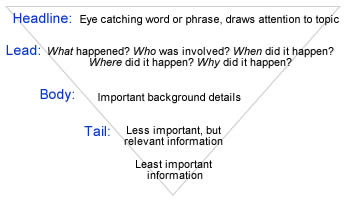News Releases
News releases, also called press releases, are a quick and widely used method of initiating media coverage. You can send a news release to multiple outlets at once, increasing the likelihood of your story being run. An effective news release quickly convinces a journalist that the event is newsworthy and is worth being pursued.
How to Write a News Release
News releases are meant to be short, two pages at the maximum, but one page is best. They are designed to have the most important information at the top of the release, allowing it to be cut from the bottom if necessary.
- Begin with your organization's name and contact information for whoever will handle follow-up questions.
- At the top of the page, include the release date. Most news releases will begin with "For immediate release."
- Write a brief, eye-catching headline.
- Use the inverted pyramid structure to help write your news release layout. The first sentence should contain the who, what, where, why, when, and how; followed by background information; and ending with the least important information.
- Limit usage of acronyms and define any that must be used.
- Avoid jargon
- Let the facts speak for themselves.
- Be concise, keep it simple.
- Quotes can make your release more interesting by bringing in another's perspective.
- If you name people, include their job title or occupation.
- At the bottom of the page, it's a good idea to have a brief description of what your organization does, also known as a boilerplate.
- Include "###" or "-30-" at the bottom to signal the end of the press release.

Other Tips
- Never send a news release as an email attachment. Instead, copy the text into the body of the email.
- Place the recipients' email addresses under Bcc. This hides your distribution list and allows the media to focus solely on your message, as well as avoids issues with 'Reply All.'
- Reserve news releases for real news. Sending out occasional, strong releases is better than frequent, weak releases.
- Sending out fact sheets and other packaged information, rather than just the news release, can help establish you as a reliable source. View the media kits page of this toolkit for more information.
- Be aware of local news. If you are competing for space with breaking news or a large story, your release might not get covered.
